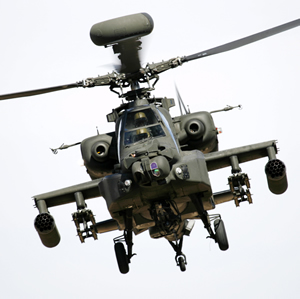Attack helicopters under NATO command were used for the first time on 4 Jun 2011 in military operations over Libya as part of Operation Unified Protector. The helicopters struck at a radar station and a military checkpoint around Berga, military vehicles and ‘command buildings’ in another, unspecified location. “This successful engagement demonstrates the unique capabilities brought to bear by attack helicopters,” said Canadian Lt. Gen. Charles Bouchard, commander of NATO’s Operation Unified Protector. “We will continue to use these assets whenever and wherever needed, using the same precision as we do in all of our missions.”

Following the rapid preparation and successful testing of British Army Air Corps WHA-64 Apache operations from naval platforms, British Apache attack helicopters joined the French Tiger combat helicopters and Gazelle scout helicopters to conduct the first operational sorties over Libya on Friday night. The Apaches were tasked with precision strikes against a regime radar installation and a military checkpoint, both located around Brega. Hellfire missiles and 30mm cannon were used to destroy the targets.In the same area, Royal Air Force ground attack aircraft destroyed another military installation, whilst a separate RAF mission successfully attacked two ammunition bunkers at the large Waddan depot in central Libya. The French helicopters attacked 15 military vehicles and five command buildings.
NATO has not released the locations of these attacks. The helicopters deployed from the British helicopter carrier HMS Ocean, and were coordinated with other allied air missions by NATO’s air operations centre, located at Poggio in Italy. The British mission, part of Operation Unified Protector, was planned alongside an operation by French Tiger helicopters from the ‘Mistral’ Class helicopter assault ship Tonnerre. The French Army is using the HAP version of the Tiger, carrying 68mm rockets and a 30mm. However, unlike the Apache, the HAP model lacks precision guided weapons, and can only deploy with air-to-air Mistral missiles for self defense. Other Tiger operators (Germany, Australia and Spain have guided weapons capability – namely PARS 3LR, Hellfire II and Spike LR, respectively.)


The timing and locations of targets for this coordinated attack were carefully selected, amid growing criticism about the collateral damage caused by NATO air attacks. “The use of attack helicopters provides the NATO operation with additional flexibility to track and engage pro-Qadhafi forces who deliberately target civilians and attempt to hide in populated areas” said the official NATO announcement. “NATO forces are constantly reviewing their operations and use of available assets, including attack helicopters, to best maintain the momentum and increase the pressure on pro-Qadhafi forces.” “Our understanding of the detailed disposition of Colonel Qadhafi’s forces has been improving in a very satisfactory manner, despite their efforts to conceal themselves” the British MOD announcement added. “Operations to date have made good progress in securing the No Fly Zone and preventing serious loss of life in Misratah and Benghazi.
While yesterday’s operations demonstrate the capabilities of the Apache complement well the precision strike and reconnaissance missions flown by NATO fast jets, deploying the helicopters from the maritime platforms and exposing these low flying helicopters to enemy fire could be avoided, if the RAF and Royal Navy would keep their Harrier and Sea Harrier fleet for few more years, until these assets are replaced, as planned, by the F-35B. According to British news media sources, the Apaches participating in the attack on Friday night have encountered counterfire from AK-47.




















